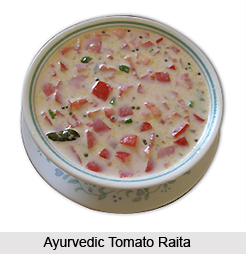 Ayurvedic tomato raita is a delicious and very healthy diet. It helps in digestion and also adds taste to the food. It is the best example of the right combination of spices and herbs that can help to balance incompatible food. This raita is very easy to prepare and can be made at home. It requires all those ingredients that can easily be availed in the market. The basic ingredients are mainly fresh tomatoes, ghee, cumin seeds, coriander leaves etc.
Ayurvedic tomato raita is a delicious and very healthy diet. It helps in digestion and also adds taste to the food. It is the best example of the right combination of spices and herbs that can help to balance incompatible food. This raita is very easy to prepare and can be made at home. It requires all those ingredients that can easily be availed in the market. The basic ingredients are mainly fresh tomatoes, ghee, cumin seeds, coriander leaves etc.
Ingredients of Ayurvedic Tomato Raita
•One cup of yogurt
•Four cups of fresh tomatoes chopped
•Two tablespoon of ghee
•Half teaspoon of cumin seeds
•Five fresh curry leaves
•A pinch of hing
•Handful of coriander leaves
•A green chopped chilli
•One-fourth teaspoon of salt
Method of Preparing Ayurvedic Tomato Raita
•Wash the tomatoes, and chop them not very finely to make the Ayurvedic Tomato raita.
•Gently mix it with yogurt and keep it aside.
•Heat small pan on medium flame and put the ghee. When hot, add mustard seeds, cumin seeds, curry leaves along with hing.
•When the seeds pop add the coriander leaves and chilli. Stir for some time and remove from the fire.
•Pour the spices in to the tomato and yogurt mixture.
•Add the salt and mix it carefully; it should not mix together fully and the Ayurvedic Tomato raita is ready for serving.
Benefits of Ayurvedic Tomato Raita
•Ayurvedic tomato raita helps in digestion.
•It adds taste to the food.
•It is light so is easy to digest and assimilate.
•It keeps the stomach cool during summer.
•Tomato is rich in water hence the raita helps in eliminating toxins.
•Tomatoes contain lycopene; this compound has powerful anticancer properties.
Ayurvedic tomato raita is quite nutritious and appetizing. The raita is also a delight for the health conscious people as it is low on calorie. The Ayurvedic tomato raita can be teamed up with pulao, biryani or even with roti-sabzi or dal-rice.




















